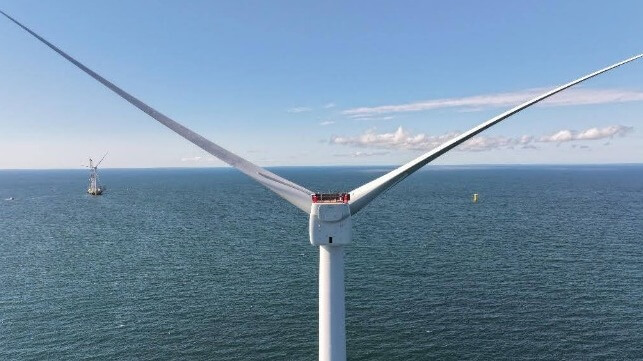
Vineyard Wind Delivers Power as First Large US Offshore Wind Farm
Article courtesy of Maritime Executive.
The United States’ first large-scale offshore wind farm delivered its first power onto the Massachusetts’ grid late on Tuesday and while mostly ceremonial it still was a much-needed positive sign for the emerging industry. Vineyard Wind being developed by Iberdrola Group’s Avangrid and Copenhagen Infrastructure Partners was a few days behind its goal of year-end power but still achieved its early-stage commissioning milestone while also becoming the largest U.S. offshore wind farm and the second major wind farm commissioned in recent weeks in the U.S.
The companies worked hard to meet their end-of-year target, with reports that first power was generated on Sunday from one of the five installed turbines in a project that will ultimately consist of 62 wind turbines generating 806 MW. Final testing and efforts to synchronize all the components however meant that the first power was not supplied to the grid till just before midnight on January 2. One turbine supplied approximately five megawatts. The other four installed turbines are undergoing testing and are expected to begin generating power in the coming weeks.
“This is a historic moment for the American offshore wind power industry,” said Massachusetts Government Maura Healy. “Soon Vineyard Wind will be producing power equivalent of over 400,000 homes.”
It has been a long process to get the project to this point with the review and planning process having been underway since 2017 for the project located 15 miles south of Martha’s Vineyard. It cleared federal reviews in 2021 with construction beginning in July of that year and offshore work just over a year ago. By December 2023, the first five turbines were installed and the company is now saying that they will all be at full capacity early this year. Power from the project interconnects to the New England grid in Barnstable, Massachusetts, transmitted by underground cables that connect to a substation further inland on Cape Cod.
“This truly is a milestone for offshore wind and the entire renewable industry in North America,” said Tim Evans, Partner at CIP and Head of North America. “For the first time, we have power flowing to the American consumers from a commercial-scale wind project, which marks the dawn of a new era for American renewables and the green transition.”
Vineyard Wind is a larger scale project than Ørsted and Eversource’s South Fork Wind located off Long Island which delivered its first power at the beginning of December 2023. The first wind farm in New York, it had its first two of a total of 12 turbines installed. Located 35 miles east of Long Island, the project is now approaching the halfway mark for a total of 12 turbines that will be installed. When complete, South Fork Wind will generate approximately 130 megawatts of renewable energy, enough to power approximately 70,000 Long Island homes.
Other U.S. offshore wind farms are progressing including Dominion Energy’s which will begin construction in Virginia. The federal government is also moving forward with it is lease auctions and project reviews. Several states are also conducting solicitations with more scheduled for 2024.
The industry however is confronting developmental and financial challenges. Higher interest rates and inflation conspired to change the economics of the projects leading to Ørsted canceling major projects and reviewing others as it said it would take a $5 billion write-off from its U.S. wind energy portfolio. BP and Equinor announced today that they had agreed with New York State regulators to cancel a power purchase agreement due to the changing economics following others that have walked away from Massachusetts projects.
The companies have been arguing that to make these projects financially feasible they need to reset their power purchase agreements to reflect the changes. At the same time, supply issues, delays in the construction of ships, and a shortage of installation capacity are all contributing to the challenges. Analysts doubt the U.S. can meet its goal of 30 GW of offshore wind energy generation capacity by 2030, but the federal government highlights that it is pushing forward the reviews and taking further steps to facilitate the development.
